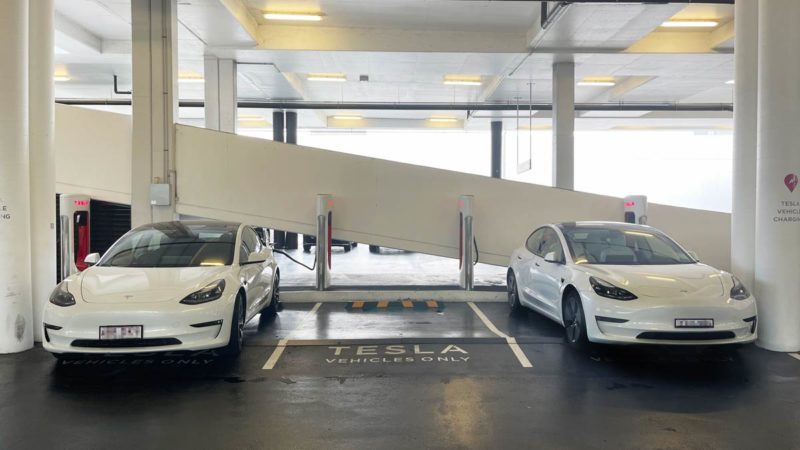Australia is headed for a supply crunch as consumer demand for electric vehicles leaps ahead of the ability of the world’s car makers to bring enough EVs to the country.
New data released on Monday has shown that while new EV registrations tripled from 2020 nearing 21,000 in 2021, sales could and should have been much higher.
It’s widely accepted that a global chip supply shortage has affected the production of many car models, but EVs are still being sold en masse overseas. The International Energy Agency reported on Monday that 6.6 million EVs were sold in 2021 worldwide, up from 3 million in 2020, and reaching close to 9% of the global auto market.
But not in Australia. The new data shows that while 20,665 EVs were registered in Australia in 2021 (corrected from a previous 24,078 due to an error by Tesla), six out of 10 of these sales were made by Tesla, even though there are some 30 EV models available locally.
The main reason is simple: Tesla is able to fulfil deliveries of its popular Model 3 and does not limit orders (noting that the Model S and Model X have been on hold since the end of 2020), while legacy carmakers are at the behest of overseas HQ that are under pressure to meet vehicle emissions targets elsewhere.
That brings at least some of the blame back to the policy vacuum in Australia. Electric Vehicle Council CEO Behyad Jafari said this morning that Australia is “stuck in the past.” He says that if there were strict vehicle emissions regulations in place, carmakers would put more effort into selling zero-emissions options locally.
This is having an impact on some of the most desirable EVs, including those that have won multiple awards overseas and which have generated huge interest in Australia.
As The Driven has previously noted, the Australian arms of carmakers introducing well-received EV models such as the Hyundai Ioniq 5 and the Polestar 2 are having trouble securing enough supply. Tranches of just a few hundred of each model have been made available to begin with, with Kia’s latest EV – the EV6 – also falling to the same fate.
One reader who ordered a Polestar 2 in late 2021 told The Driven they were told they would be waiting until mid-2022 for their vehicle.
Another reader tells The Driven that they ordered a BMW iX 50 in October 2021, but could be waiting 12 months for their vehicle. “I was told that it was in production in mid-December. Now I’ve been told it won’t go into production until July this year, for delivery later in the year,” they said in a note to The Driven.
While they said the dealer told them there are problems with chip delays, BMW reported in January that it sold almost 38,000 units of its all-electric iX3 worldwide in 2021.
While the iX3 is yet to make it onto Australia auto sales charts, just 35 iX were registered in local sales for 2021. The Driven has reached out to BMW to determine the hold up and will update this article if more information comes to hand.
Volkswagen has made it clear on numerous occasions it will prioritise sales of its all-electric ID series to overseas markets as long as there is no policy pressure in Australia. It went so far as to call Australia “third world” on the EV policy stage.
This is depsite the fact that three states (NSW, Victoria and South Australia) offer EV purchase incentives, and the ACT is also offering $15,000 interest-free loans to help buy an EV. Queensland has hinted at some incentives of its own.
But it is hard for carmakers to make the case to global head offices when Australian policy levers are weaker than those in other countries.
The federal Coalition government, after promising a federal EV strategy for mid-2020, failed Australians when it finally introduced a “Future Fuels Strategy” in 2021 that was lambasted as a fizzer with no grand plans. It couldn’t even bring itself to put the term “electric vehicles” in the title.
With the next federal election looming, the pressure is on the government more than ever to introduce vehicle emissions standards if Australia’s transport sector is to level up to lower its carbon emissions, reduce climate impacts, and improve society’s general health and well-being.
There are a few lights at the end of the carmaker tunnel, perhaps. With Tesla’s Berlin gigafactory nearing production it is only a matter of time before Shanghai Model Y inventory is surely freed up for markets at the end of the world like Australia and New Zealand.
And, in a possibly positive note from VW Australia: in response to a query from The Driven, while there is no word yet on when the ID4 will be fast tracked, the Cupra Born’s arrival is all but cemented.
A spokesperson said the company is flying three units in for”extensive local testing and data analysis,” signalling that “the Born’s position as Cupra’s halo car is implicit” in its role as the all-electric vanguard for the brand’s first foray outside Europe.

Bridie Schmidt is associate editor for The Driven, sister site of Renew Economy. She has been writing about electric vehicles since 2018, and has a keen interest in the role that zero-emissions transport has to play in sustainability. She has participated in podcasts such as Download This Show with Marc Fennell and Shirtloads of Science with Karl Kruszelnicki and is co-organiser of the Northern Rivers Electric Vehicle Forum. Bridie also owns a Tesla Model Y and has it available for hire on evee.com.au.


